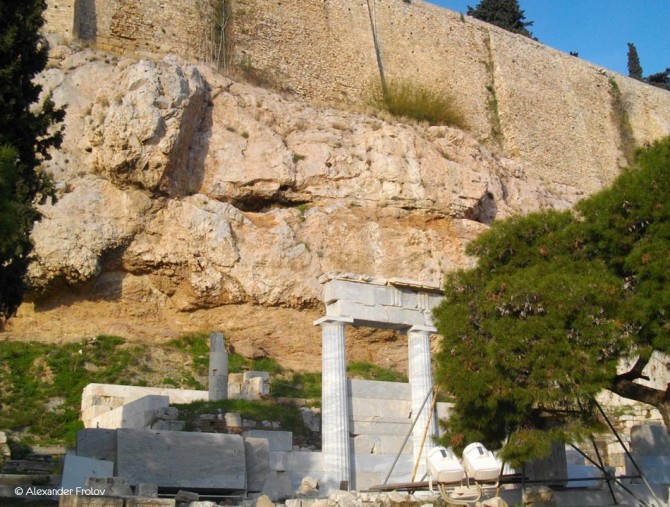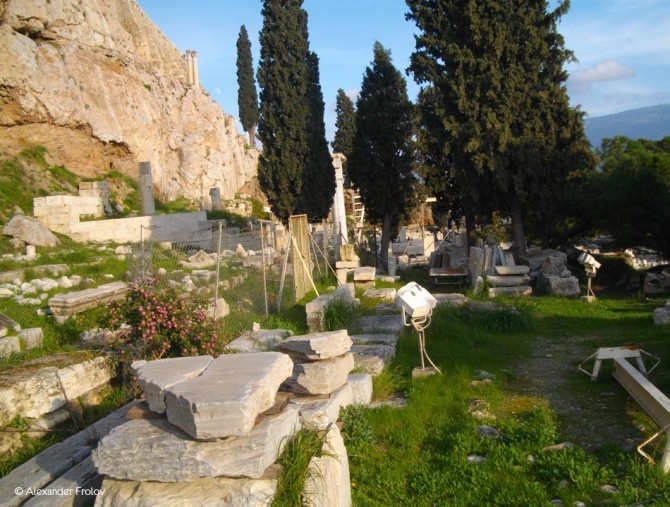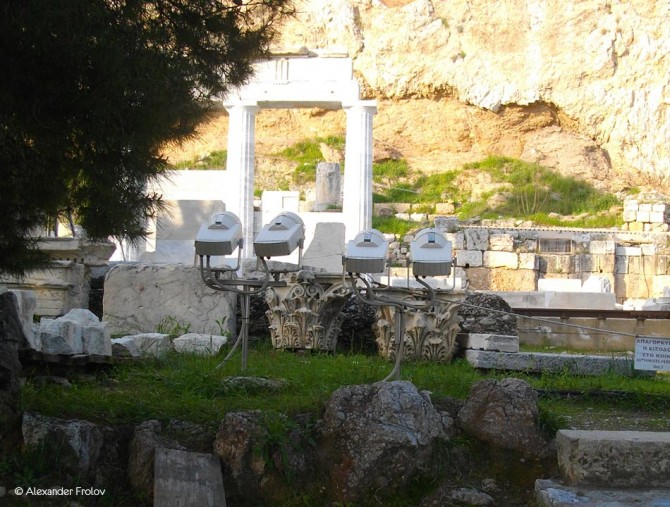Асклепион Акрополя
Асклепионов в Греции немало - самый крупный из них находится на Пелопоннесе, а один из расположен рядом с афинским Акрополем, на его южном склоне. Афинский Асклепион считался вторым по важности храмом города после храма Диониса. Он был построен в 420-19 годах до н.э. и состоял из алтаря и трех аркад. Считается, что Асклепеон был частично разрушен в 86 году до н.э. римским Суллой или в 267 году н.э. герулами. Однако, был восстановлен почти сразу же. В дальнейшем, V или VI веке храм был снова разрушен, на этот раз византийцами, которые возвели на месте Асклепиона трехнефную базелику, посвященную Святому Анаргирусу. Дальше, после турецкого вторжения, начиная с 1457 года здание было полностью заброшено.
Руины святилища были найдены лишь спустя четыре столетия в 1876 году. Восстановительные работы ведутся до сих пор.
В наши дни можно увидеть руины дорической стои, располагавшейся в восточной части здания. В западной части, по видимости, находилась трапезная храма. Храм и алтарь были построены в V веке до н.э., однако те руины, которые можно увидеть сейчас датируются эпохой Древнего Рима. К сожалению, артефакты, найденные на этом месте, находятся в нескольких разных музеях как в Греции, так и за границей.
Как добраться до Асклепиона Акрополя:
- на метро, станция Акрополи
Часы работы: 8:00-20:00, цена билета: 2 евро
Также возможен вход по билету за 12 евро, дающего право посещения Акрополя и всех важнейших археологических сайтов Афин. В их число входят: Древняя агора, Римская агора, Кладбище Керамейкос, Храм Зевса Олимпийского, Библиотека Адриана и другие.
Фото и текст: Александр Фролов
Asclepeion (Acropolis)
Asclepius was the God of medicine in Ancient Greece and although he was not in the top10 of the ancient Greek gods, he hold an important position. After all, he was the first known doctor of the antiquity, and his sanctuaries operated as sanatoriums. His cult started in the Ancient Triki (in Thessaly), was spread in Peloponnese and then in Attica, first in Piraeus and after in Athens. The Athenian Asclepeion was built in the South Slope of Acropolis and it was the second most important temple after the one of Dionysus.
It was founded in 420/19 BC, at the north of the Theater of Dionysus and was consisted by a temple with an altar and three arcades (Stoes). It is believed that it was partly destroyed either from the Roman Sulla in 86 BC or by the Erouli in 267 AD, but in any case it was rebuilt immediately. It was probably completely destroyed in the 5th or the 6th century AD and was replaced by a three-aisled basilica, which was dedicated to Agious Anargyrous, the saints healers of Christianity. After the Turkish invasion, however, in 1457, the place was totally abandoned.
The ruins of the sanctuary were found 4 centuries later, in 1876-77 and the last few years works of restoration are taking place.
What will you see today? At the east of the temple there are the ruins of the Doric Stoa. It was a large, two storey building, that operated as the space for the slumber and the healing of the patients. The temple and the altar were built in the 5th century BC, but the foundations that are visible today probably dated in the Roman Times. At the west of the temple there was another building (Stoa), which was probably the restaurant of the sanctuary.
Fragments of the monument that have been found are guarded in various museums of Greece and abroad (how original!).
Asclepeion, South Slope of Acropolis, Athens, metro station Acropolis. Visiting hours: Daily, 8:00-20:00. Last entrance: 19:30. Ticket prices: Full: 2 euros, Reduced: 1 euro. Special ticket package: Full: 12 euros, Reduced: 6 euros. Valid for: Acropolis of Athens, Ancient Agora of Athens - Areopagus, Archaeological Museum of Kerameikos, Hadrian’s Library, North Slope of Acropolis, Kerameikos, Museum of the Ancient Agora of Athens, South Slope of Acropolis, Olympieion, Roman Agora of Athens.
Τext: Marilou Pantazi



